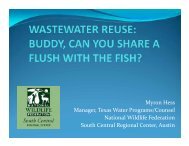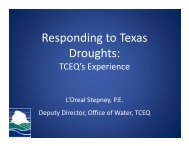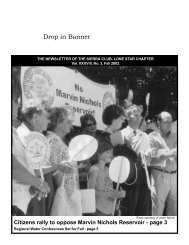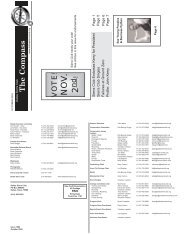comments in PDF - Lone Star Chapter, Sierra Club
comments in PDF - Lone Star Chapter, Sierra Club
comments in PDF - Lone Star Chapter, Sierra Club
Create successful ePaper yourself
Turn your PDF publications into a flip-book with our unique Google optimized e-Paper software.
“achiev<strong>in</strong>g a balance between population and resource use” mean The public and<br />
decision-makers need this <strong>in</strong>formation so they can review, comment on, and understand<br />
the proposal.<br />
57) Page 128, Alternatives or Actions Considered But Dismissed From Detailed<br />
Evaluation, NPS states “Protect air quality – Although the park is classified as a Class<br />
1 air quality management area, the park staff has limited ability to address air pollution<br />
that drifts to the park from regional sources, particularly pollution sources <strong>in</strong> Mexico”.<br />
NPS does have a lot of authority to review permits, to urge EPA and TCEQ to do their<br />
jobs, to work with Mexico to reduce air pollution. NPS should not play helpless s<strong>in</strong>ce it<br />
is the public’s park and air resources that suffer. The public deserves better. Air quality<br />
should be an issue topic <strong>in</strong> the draft GMP/EIS and not cast aside because NPS says it<br />
is helpless to do anyth<strong>in</strong>g.<br />
58) Page 129, Alternatives or Actions Considered But Dismissed From Detailed<br />
Evaluation, the <strong>Sierra</strong> <strong>Club</strong> agrees that motor vehicle access to the high country;<br />
mounta<strong>in</strong> bike use on trails; sell<strong>in</strong>g or leas<strong>in</strong>g portions of park lands; the tram to<br />
Guadalupe Mounta<strong>in</strong>; and road from Williams Ranch to the west; are <strong>in</strong>appropriate <strong>in</strong><br />
GMNP.<br />
59) Pages 131-138, Table 6, Features of the Alternatives, NPS must def<strong>in</strong>e<br />
“aggressive management” for exotic species”; “Eradicate target <strong>in</strong>vasive species” (what<br />
species); “more strict prevention measures”; “More aggressively protect water quality<br />
and quantity”; “Stabilize and preserve”; “site restoration”; and other similar phrases.<br />
The public and decision-makers need this <strong>in</strong>formation so they can review, comment on,<br />
and understand the proposal.<br />
60) Pages 139-143, Table 7, Summary of Impacts, Alternative B, NPS states “The<br />
elim<strong>in</strong>ation of the hammer<strong>in</strong>g action of horseshoes on fossil deposits <strong>in</strong> trails would<br />
have a long-term, beneficial impact”. Why is NPS propos<strong>in</strong>g <strong>in</strong> the Preferred Alternative<br />
to cont<strong>in</strong>ue to allow this “hammer<strong>in</strong>g action of horseshoes” at the present levels The<br />
public and decision-makers need this <strong>in</strong>formation so they can review, comment on, and<br />
understand the proposal.<br />
On page 144, Alternative B, removal of cultural structures so they can be protected is<br />
a positive and not adverse effect. On page 145, allow<strong>in</strong>g Manzanita Spr<strong>in</strong>g to fill<br />
naturally is not an adverse impact on the cultural landscape because it is what the<br />
settlers found when they first arrived. On page 147, clos<strong>in</strong>g the road to the Salt Bas<strong>in</strong><br />
Dunes park<strong>in</strong>g area has a positive impact environmentally and would require people to<br />
enter Wilderness on its own terms and not theirs. On page 148, Alternative B, NPS<br />
has shown no documentation that there would be “<strong>in</strong>creased demand for commercial<br />
camp<strong>in</strong>g and other overnight lodg<strong>in</strong>g”. Park ma<strong>in</strong>tenance should be lower and<br />
beneficially affected by Alternative B because there will be fewer facilities and horse and<br />
frontcountry camp<strong>in</strong>g use would be elim<strong>in</strong>ated. So how does NPS come up with a<br />
“Moderate, long-term, adverse impacts” on ma<strong>in</strong>tenance This makes no sense. The<br />
25







